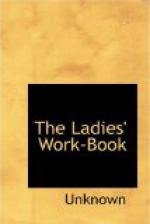MECKLIN WHEELS (No. 19). Work Venetian bars on a single thread, in one direction, at equal distances. Then take a thread in the opposite direction, and cover it also with button-hole stitch a little beyond the first cross. Take another needle and thread and work a few stitches, in the form of a circle, round each cross, so that by slipping the first needle through every stitch, a foundation may be formed for the button-hole work with which the wheel is made, a single Raleigh dot being added between every two threads. The stitches taken with the extra needle should form a sort of railroad for holding the thread in its place. This mode of working wheels will be found very superior to the old one of pinning down the circle of thread. When all the wheels are worked, the stitches made with the extra needle should be cut away at the back.
HENRIQUEZ LACE (No. 20). This stitch, and the one that follows it, are invariably worked with the finest thread manufactured. Like English lace, it has a better effect done on diagonal bars, than on those which are taken straight up and down, or across a space. Make one twisted bar across the space, then take a single thread nearly close to it. Twist it twice round, then darn a spot on the two threads; twist five or six times round, darn another, and repeat to the end. Do all the lines in one direction first, making the spots fall one beneath the other. Then begin the lines in the opposite direction, taking the thread under in one way, and over in returning, whilst, in order to keep the close bars apart, the thread must be twisted between them. Care must be taken that the bars in one direction, fall between the spots in the other.
CORDOVAN LACE (No. 21). Worked like the preceding; but with three bars in each line instead of two.
VALENCIENNES LACE (No. 22). This stitch also is done with the finest threads made. It is simple darning, of the closest and finest description, done with so much regularity that it resembles cambric.
BRABANT EDGING is a name sometimes given to a union of the Brussels with the Venetian edging. A row of Brussels is first worked, and on it a row of Venetian. The diagram gives the effect of this arrangement.
Another variety of edging is produced by two or three rows of Brussels being worked on one another. This is frequently seen in old lace; and, with Venetian on the outer edge of the braid, is often termed Lyons Point.
When spaces similar to those in the accompanying diagram are to be filled with Brussels lace, the best way is to work each side to the centre, and then run the needle up the middle, catching up alternately a stitch on each side. Sometimes the centre is not closed up at all.
The diagram in page 132 gives a specimen of a modification of the Little Venetian Lace. The first stitch is taken as usual, but is followed by three others, worked as closely as possible. A space equal to that of four stitches is left between every four. In the second row, the four stitches are worked on the loop. The engraving also shows how the stitches are adapted to the different spaces in a pattern.




